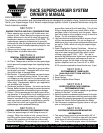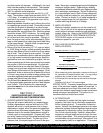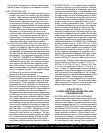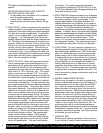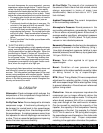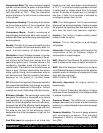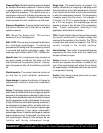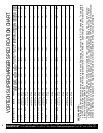
© 2000 Vortech Engineering, Inc. All Rights Reserved. International Copyrights Secured. 25FEB00 V 2.0 DRAFT P/N: 008515
Questions?
Please contact: Vortech Engineering, Inc. • 1650 Pacific Ave., Channel Islands, CA 93033-9901
Phone: (805) 247-0226 • Fax: (805) 247-0669 • Website: vortechsuperchargers.com • Hours: M-F 8AM - 4:30PM (PST)
Pressure Ratio: Manifold absolute pressure divided
by standard barometric pressure. Pressure Ratio
= gauge pressure + atmospheric pressure divided
by the absolute pressure. The vertical scale on a
compressor map and it indicates the pressure rise
across the compressor. It is scaled this way instead
of psi because the inlet conditions are unknown.
Pressure Regulator: A spring loaded relief valve
that returns excess fuel to the tank to maintain
system pressure.
PSI: (Pound Per Square Inch) PSI can be a
measure of air or fluid pressure.
SAE J1723: The only way to evaluate the efficiency
of a centrifugal supercharger. It outlines the
procedures for testing and then presenting results
in accurate and usable compressor maps. See
www.sae.org/Prodserv/stds/J1723_199508.htm.
Speed Lines: On a compressor map, pressure at
any given speed is relatively the same until the
inlet chokes and the pressure falls off. Usually,
when the pressure falls off, the efficiency also falls
off.
Stoichiometric: The correct chemical mixture of
air and fuel to yield complete combustion.
Supercharge: Increase the density of charge by
compressing it before it enters the combustion
chamber.
Surge: Compressor surge is a condition that occurs
when there is insufficient air flow to support a specific
pressure on the compressor outlet side. It often occurs
during vehicle deceleration when the throttle is closed,
but the compressor is still at high speed. It can occur
at high RPM and small throttle opening conditions if
the compressor has been refit to run faster and it can
be a chronic problem if the incorrect supercharger
has been selected. It can cause catastrophic
supercharger failure. It heats the discharge air, reduces
engine response and, if prolonged, can heat soak
the supercharger. Mass air flow sensors do not
function well during compressor surge.
Surge Line: The lowest flow for any speed. It is
audibly identified by a coughing or banging noise
and physically by a very high temperature. A volume
of air rushes out the inlet, only to be sucked back
in when the compressor recovers. The temperature
increases every time this occurs. For example, if
a Vortech V-4 XX-Trim supercharger is installed
on a 2.0 liter engine, the supercharger would
operate in surge or the left side of the compressor
map. Proper compressor matching to the
application eliminates this problem.
TPS: (Throttle Position Sensor) Sensor that provides
the control module with a variable voltage that
represents the position of the throttle. The TPS is
a sealed unit and cannot be repaired. The TPS is
usually located in the throttle housing.
Valve Overlap: The number of crankshaft degrees
expressing the time when both the intake and
exhaust valves are open.
Volute: A scroll or snail shape housing used to
contain the impeller and diffuser. Located at the
rear of the supercharger unit where the air enters
the supercharger. Sometimes referred to as a scroll
or compressor housing.
Vortex: Free flowing inward spiral such as seen
at the drain of a bathtub.
7



